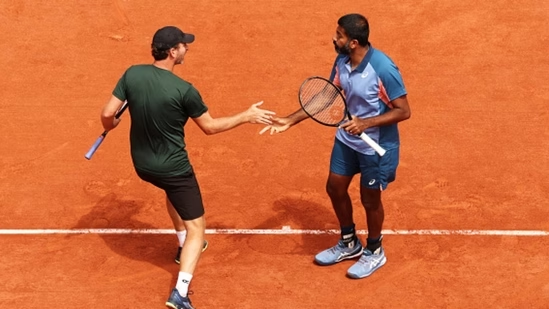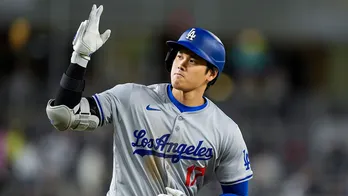Bopanna's semi-final defeat highlights the doubles whammy
Super tiebreakers have brought joy to Rohan Bopanna and Matwe Middelkoop at this French Open. So, when Bopanna missed a straightforward overhead on the opening point of the first-to-10 points dash on Thursday, there was a sense of disbelief and a sign of the reversal of the trend.  PREMIUM
PREMIUM
Sure enough, unlike in their previous two comeback victories, the 16th-seeded Indian-Dutch pairing lost the super tiebreaker, and with it the French Open men's doubles semi-final 6-4, 3-6, 6-7 (8-10) to the Jean-Julien Rojer and Marcelo Arevalo. It was a patchy performance by Bopanna and Middelkoop, given they managed to pull off dramatic victories by saving five match points in the third round and overturning a 0-3 deficit in the super tiebreaker of their quarter-final.
Bopanna, playing his first men’s doubles Slam semis since 2015, and Middelkoop got the early break in the third game courtesy some crisp return winners to win the opening set, but a dip in their own serving efficiency brought the Dutch-Salvadoran combo back in the second set with a break in the eighth game. Neither pair could cause much trouble to the other’s serve in the deciding set. Bopanna and Middelkoop saved a couple of match points in the super tiebreaker but when the latter erred in hitting a backhand return wide, the 12th seeds completed the turnaround on a team that had momentum on its side from the last two matches.
Arevalo and Rojer teamed up only at the start of the year, and will face the unseeded pairing of Ivan Dodig and Austin Krajicek in the doubles final. That match-up for the title is perhaps an apt reflection of the overall inconsistency that has crept into modern-day doubles tennis, especially on the prestigious Grand Slam stage.
Doubles whammy
Gone are the days of the Bryan brothers (Bob and Mike Bryan) and the Woodies (Todd Woodbridge and Mark Woodforde), or the Williams sisters (Serena and Venus) and Martina Navratilova and Pam Shriver among the women pairs. They not just attracted bums to the seats but also injected stability and strength to the doubles game.
The Woodies won 11 Grand Slam doubles titles together, including four of the five from the 1996 to the 1997 Wimbledon. The legendary Bryan brothers held all four Slams at one point (2012 US Open and the Australian Open, French Open and Wimbledon in 2013). In the last seven years, save Mike Bryan-Jack Sock and Juan Sebastian Cabal-Robert Farah in 2018 and 2019 respectively, no men's pair has won back-to-back Slams. This year's Australian Open doubles crown was bagged by Aussie wildcards Nick Kyrgios and Thanasi Kokkinakis, both primarily singles players who paired up at Melbourne Park to have some fun.
Missing star power
Ironically, doubles, in recent times, is increasingly lacking in star power that the singles pros invariably brought to the table not too long ago. Navratilova and Shriver, both quality singles players, were a destructively dominant duo in the 1980s while the Williams sisters tested plenty of success dabbling as a team on the court. In the list of men's doubles Grand Slam winners, you'd also find mentions of John McEnroe and Stefan Edberg, among others.
In this day and age of brutal baseline tennis involving marathon matches in singles, top singles players switching to doubles duty is a rare phenomenon. Currently, none of the top-10 ranked male singles players compete in doubles in Grand Slams while there's just one doubles Slam winner (Barbora Krejcikova) among the top 10 women.
At home, Bopanna and Sania Mirza continue carrying the doubles flag—and Indian tennis’—on their shoulders, yet not with the kind of success they did in the past. Mirza’s last Grand Slam title came in 2016, while Bopanna’s wait for another men’s doubles final appearance in a Slam extends after the 2010 US Open title clash with Aisam Qureshi. That was a time the two also enjoyed the company of more established partners, which created a buzz—Bopanna and Qureshi dubbed the Indo-Pak Express and Mirza and Martina Hingis, for example—and carried forward the doubles legacy set high by Leander Paes and Mahesh Bhupathi.
The Indian duo not only delivered Grand Slam trophies, inspiring tennis and the controversies to go, but also brought the eyeballs, headlines and the cool factor into doubles. That seems to have gone missing, not just from an Indian perspective but the doubles ecosystem as a whole.
There’s perhaps no better time to revisit Mike Bryan's words in an interview to this paper in 2020. “Doubles needs a little bit of love,” he said. “It’s never going to be as big as singles, but it just needs a little bit of extra attention.”
Experience unrestricted digital access with HT Premium
Explore amazing offers on HT + Economist Start 14 Days Free Trial Already Subscribed? Sign In
Disclaimer: The copyright of this article belongs to the original author. Reposting this article is solely for the purpose of information dissemination and does not constitute any investment advice. If there is any infringement, please contact us immediately. We will make corrections or deletions as necessary. Thank you.







